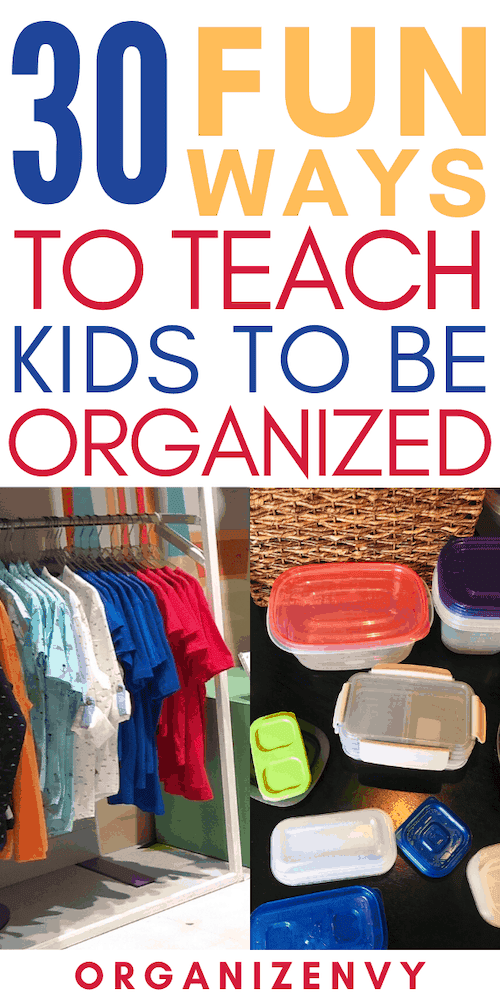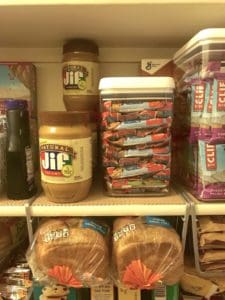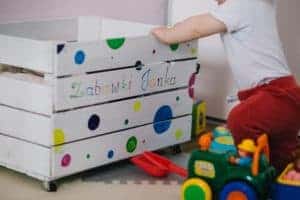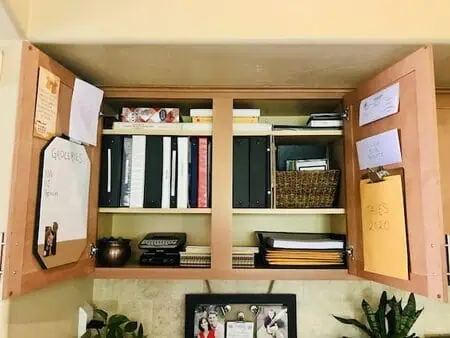Those of us who have the kids at home right now are all going “back to school,” learning how to juggle our professional work, housework, and online learning or home schooling. It’s an interesting time, to say the least!
Why not teach kids to be more organized around the house (and have fun doing it)?
PIN this image to save the article for future reference:

With everyone under the same roof, it can be a challenge keeping the house tidy and decluttered. And when the house is a mess, everyone feels more grumpy and stressed.
Think of it as a homeschooling “home economics” course. Kids like to feel helpful and useful, and this is a great way to show them the importance of running a household.
Plus, as Scholastic states, incorporating fun activities is an important way to develop their organizational skills for life.
This video illustrates the importance of teaching kids organization at a young age. Grab the kids and have them watch with you, then scroll down for some fun organizing activities!
30 Projects That Teach Kids To Be Organized Around the House
Here are some ways parents can include kids in fun, easy organizing projects that help them learn, too. (Even teenagers!)
As an Amazon Associate, I earn from qualifying purchases, which costs you nothing. Please read the Disclaimer for more information.
Pantry Organization

The pantry is a great place to start teaching kids about organization and decluttering.
Younger kids can:
- Help sort pantry items by size, shape, color, etc. (For instance, canned goods go in one pile, boxes in another, jars and bottles in a third.)
- Sort by reading labels and grouping by name, i.e. types of soup or canned vegetables.
- Create groupings of foods that are typically eaten together, like peanut butter, jelly and bread, or soup and crackers.
- Arrange spices in alphabetical order.
- Match food storage containers with lids.
Older kids and teenagers can learn a lot about managing a household through pantry organization. Have them:
- Tally the numbers of each type of food you have on hand.
- Arrange items by expiration date to help you consume foods that will go stale or expire first.
- Estimate when you’ll need to replenish items based on how often your family consumes them, or how many servings you have.
- Help budget for future purchases by determining the cost of food items.
- Create grocery lists based off the weekly or monthly budget and items that will need to be purchased.
- Try to stretch the budget by studying grocery store circulars, online sales, collecting coupons, etc.
RELATED:
DIY Weekend Pantry Makeover
Playroom Organization

The playroom is a notoriously difficult space to keep organized and clean. And this is especially true with kids at home for an extended period of time.
Include children in deciding how their toys and games are arranged, so they can have some control over their space. They’ll see how much easier it is to find and use their favorite things when everything is tidy.
Plus, keeping items off the floor gives kids more space to move and play in creative ways.
Younger kids can:
- Find and group items that match, like blocks, LEGO pieces, playing cards, board game components, crayons and pens, PlayDoh containers, stuffed animals, etc.
- Sort items they play with all of the time and want to keep and items that are ready for donation or sale.
- Find items that are broken or missing parts and add them to the trash/recycle pile.
- Organize items in alphabetical order, or small to large, or by color.
Older kids can:
- Design stations that make efficient use of space and items, i.e. set up a small table and chairs for board games, with the games stored nearby.
- Find items in other areas of the house that can be used as bins and containers for playroom items (cardboard boxes, Tupperware with missing lids, etc.) BONUS: decorate or supervise younger kids in decorating the containers with labels.
- Keep a list and take pictures of all items to be donated, and determine the value of the donations for tax purposes. (Check out ItsDeductible, a free app by TurboTax.)
- Keep a list and take pictures of all items to be sold, and determine the value by researching similar items listed on online marketplaces.
RELATED:
5 Reasons An Organized Life Saves Money
Back to School Organization: Tips for Kids & Parents
Sensational Toy Storage! Organize and Declutter Stuffed Animals, LEGOs, Dolls & More
Closet Organization

Another area that can be difficult to keep organized is the closet. Closets are receptacles for anything that we want to hide from view.
As a result, it’s easy for them to become cluttered wastelands of despair. Make closet organization a learning opportunity! Teach kids to be organized by sorting and arranging their clothes. Here’s how:
Younger kids:
- Sort clothes by color and type.
- Match shoes.
- Match socks (at least by color).
- Act as “mannequins” in fun poses while you have them try on clothes to see what they’ve outgrown.
- Sort and group items that belong in other areas of the house, like games and toys, books, dishes, etc.
Older kids:
- Sort through clothing and shoes they’ve outgrown and are ready to donate or sell.
- Take photos and create a list of items ready for donation, and determine the value for tax purposes. (Check out ItsDeductible, a free app by TurboTax.)
- Take photos and create a list of items to be sold. Determine the value by researching online marketplaces.
- Reorganize clothing by type and color (shorts, t-shirts, jeans, sweaters, etc.).
- Create outfit “sets” with tops, bottoms and accessories using hangers with clothespins, chip clips or binder clips.
- Find unused bins, boxes and containers in other areas of the house that can be repurposed as storage for seasonal clothing, books, photos, etc.
RELATED:
Easy DIY Closet Organizing Ideas
Beautiful Baby and Nursery Organization Ideas
How to Organize a Teen’s Bedroom
Build a Family Command Center Together

A family command center is a centralized place, often located in or near the kitchen or entryway, where you can keep everyone’s schedules, important papers, lists, chore charts and more.
It can be as simple or as complex as you need for your household. In the photo above, you can see that mine is fairly simple.
I’ve got a whiteboard for notes and lists, a place to collect tax receipts, and folders and binders for important school papers and home management information.
A larger family might add meal planning charts, spare car keys, hooks for backpacks, bins for permission slips and lunch money…the possibilities are endless.
Have your kids help determine what’s important to keep track of. Then task them with daily organizational activities like:
- Putting completed homework in a folder to be reviewed
- Adding permission slips to the appropriate basket for signing
- Checking off finished chores
- Adding items to the grocery list
RELATED:
Organize your life with a family command center
How Do You Teach Kids to Be Organized?
Got more ideas for incorporating learning into organization projects for kids at home? Leave a comment below!